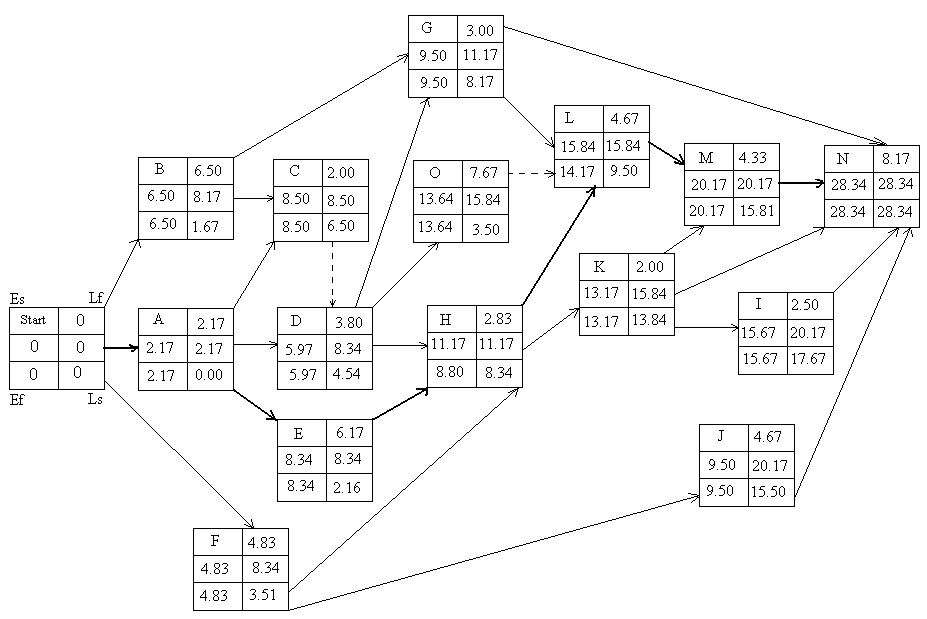The following activities (see Table 0) have been scheduled for constructing a new building for AXBC PLC. All task durations have been given in days.
Table 0.
Detailing appropriate predecessor-successor relationships for the activities
Table 1.
This table is derived from a careful sketchy drawing of the flow of the activities. The information contained can be verified from the AON network constructed in part (d) of this particular question.
The expected time and variance for the tasks
Table 2.
Formulae


The Early Start, Early Finish, Late Start, Late Finish and Slack for the tasks
Table 3.
Formulae
The Earliest Finish = Earliest Start + Duration
The Latest Start = Latest Finish – Duration
The Float = Latest Start – Earliest Start
Slack = Late finish –Early finish
An AON network reflecting the project of constructing a new building

The critical path and duration of the project
The critical path of the project is: A, E, H, L, M, and N
The duration of completing this project is 28.34 days which is approximate 28 days.
The probability of completing this project in 22 days
The variances of the critical path are shown in the table below.
Table 4.
The standard deviation of these critical path activities is, therefore,


The Z- Score is computed as below

= (22-28)/2.025= -2.9629
Assuming that the data follows a normal distribution criterion, the probability of completing this project in 22 days as in Z- table for normally distributed data is,
(1-0.99841) =0.00159
It is nearly impossible that the project will be completed in 22 days.
The probability of completing the project in 23 days
Computation of Z-score value
Z-value= (T(s)-T (e))/Sd
= (23-28)/2.025=-2.4691
As earlier assumed in the answer for (f) above, the probability of completing the project in 23 days as in the Z-score table for normally distributed data is,
(1-.99305)=0.00695
There is, therefore, a very slim chance of completing the above tasks within this time (22 days).
A brief summary on the implications of the analysis
The management needs to allot more time as the analysis has clearly shown that the management may be overly optimistic, especially as depicted in the probabilistic analysis in the last part of the analysis.
The technique is important in regards to scheduling and project control; this is necessitated by the need to use scarce diverse resources to accomplish tasks within the given time, cost and quality requirements. The project management team is required to ensure it does not exceed the budget cost. Since it uses probability, the technique is effective in helping meet deadlines through the use of alternative plans. Meeting the contract date is useful in maintaining good relations with the clients. When used in an integrated project environment, it gives experience to the project team. In addition, it is necessary for complex tasks and activities. Through breaking these tasks into smaller sub-units, it aids in the controlling function of management (Wiest et al., 1974).
In addition, the analysis facilitates understanding dependencies and improving overlapping tasks. Therefore dependencies of different activities can clearly be visualized and addressed in good time. This is very vital in the construction industry since the percentage completion is difficult to estimate, especially in the early stages. Despite its usefulness, the analysis is an estimate and based on a person’s opinion; hence it is subjective and can be biased. Its degree of accuracy is thus questionable, and the time estimates have no proven origin or source. Moreover, the project evaluation review technique does not consider cost factors and requires to be used alongside other techniques (Render et al., 1982).
It is important that the management addresses the need for experienced project managers to supervise the project in order to minimize subjectivity and the need to clearly define the scope of the project in regard to changes that need to be made in future. Finally, the management should consider incorporating other stakeholders other than the project management team in view of encouraging accountability (Render et al., 1982).
List of References
Render, Barry and Stair Jr., Ralph M. (1982). Quantitative Analysis for Management, Massachusetts: Allyn & Bacon Inc., pp. 525-563.
Wiest, Jerome D., and Levy, Ferdinand K., (1974). A Management Guide to PERT/CPM, New Delhi: Prentice-Hall of India Private Limited.